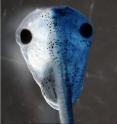Human cells, plants, worms and frogs share mechanism for organ placement
As organisms develop, their internal organs arrange in a consistent asymmetrical pattern -- heart and stomach to the left, liver and appendix to the right. But how does this happen? Biologists at Tufts University have produced the first evidence that a class of proteins that make up a cell's skeleton -- tubulin proteins -- drives asymmetrical patterning across a broad spectrum of species, including plants, nematode worms, frogs, and human cells, at their earliest stages of development.
"Understanding this mechanism offers insights important to the eventual diagnosis, prevention and possible repair of birth defects that result when organs are arranged abnormally," said Michael Levin, Ph.D., senior author on the paper and director of the Center for Regenerative and Developmental Biology at Tufts University's School of Arts and Sciences.
"The research also suggests that the origin of consistent asymmetry is ancient, dating back to before plants and animals independently became multicellular organisms," he added.
The work appears in the Proceedings of the National Academy of Science Online Early Edition publishing the week of July 16, 2012.
Co-authors with Levin are Joan M. Lemire, Ph.D.,a research associate in the Department of Biology, and doctoral student Maria Lobikin, also in the Department of Biology.
Tubulin Proteins Operate Across Species
Up to now, scientists have identified cilia -- rotating hair-like structures located on the outside of cells -- as having an essential role in determining where internal organs eventually end up. Scientists hypothesized that during later stages of development, cilia direct the flow of embryonic fluid which allows the embryo to distinguish its right side from its left.
But it is known that many species develop consistent left-right asymmetry without cilia being present, which suggests that asymmetry can be accomplished in other ways.
Levin's team pinpointed tubulin proteins, an important component of the cell's skeleton, or cytoskeleton. Tubulin mutations are known to affect the asymmetry of a plant called Arabidopsis, and Levin's previous work suggested the possibility that laterality is ultimately triggered by some component of the cytoskeleton. Further, this mechanism could be widely used throughout the tree of life and could function at the earliest stages of embryonic development.
In their latest experiment, the Tufts researchers injected the same mutated tubulins into early frog embryos. The resulting tadpoles were normal, except that their internal organs' positions were randomly placed on either the left or right side.
In subsequent experiments, collaborators at the University Of Illinois College Of Medicine and Cincinnati Children's Hospital Research Foundation found that mutated tubulins also have the same effect on left-right asymmetry of the nervous system in nematodes and on the function of human cells in culture.
Altogether, the Tufts experiment showed that tubulins are unique proteins in the asymmetry pathway that drive left-right patterning across the wide spectrum of separated species.
Importantly, mutated tubulins perturbed asymmetry only when they were introduced immediately after fertilization, not when they were injected after the first or second cell division. This suggested that a normal cytoskeleton drives asymmetry at extremely early stages of embryogenesis, many hours earlier than the appearance of cilia. Further, the Tufts biologists found that tubulins play a crucial role in the movement of other molecules to the left and right sides of the early embryo.
An Understanding of Birth Defects
"What's remarkable about these findings is that the same proteins are involved in establishing asymmetry in organisms as diverse as plants, nematodes, and frogs, and they even affect symmetry in human tissue culture cells," said Susan Haynes, Ph.D., of the National Institutes of Health's National Institute of General Medical Sciences, which partially funded the work. "This work is a great example of basic research that not only illuminates fundamental developmental mechanisms, but also increases our understanding of a class of serious human birth defects."
Other funding sources include the American Heart Association.
Source: Tufts University
Other sources
- Human cells, worms, frogs and plants share mechanism for asymmetrical patterning: tubulin proteinsfrom Science DailyMon, 16 Jul 2012, 21:00:25 UTC
- Plants and Vertebrae Share Mechanism for Placement of Organsfrom Newswise - ScinewsMon, 16 Jul 2012, 20:01:22 UTC
- Human cells, plants, worms and frogs share mechanism for organ placementfrom PhysorgMon, 16 Jul 2012, 19:00:51 UTC
